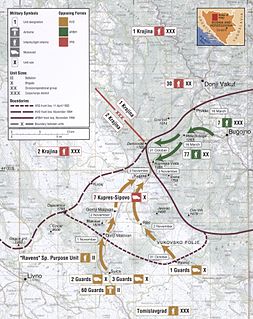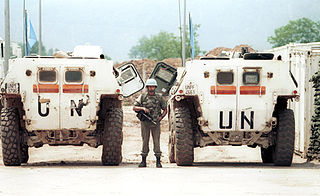 W
WThe Battle of Kupres was a battle of the Bosnian War, fought between the Bosnian Croat Territorial Defence Force supported by the Croatian Army troops on one side and the Yugoslav People's Army, augmented by the Bosnian Serb TO on the other at the Kupres Plateau, on 3–11 April 1992. During the fighting on 8 April, the Bosnian Croat TO was reorganised as the Croatian Defence Council. The objective of the battle was to control the strategic Kupres Plateau, a major supply route.
 W
WThe Battle of Kupres was a battle of the Bosnian War, fought between the Army of the Republic of Bosnia and Herzegovina (ARBiH) and the Croatian Defence Council (HVO) on one side and the Army of Republika Srpska (VRS) on the other from 20 October to 3 November 1994. It marks the first tangible evidence of the Bosniak–Croat alliance set out in the Washington Agreement of March 1994, brokered by the United States to end the Croat–Bosniak War fought between the ARBiH and the HVO in Bosnia and Herzegovina. The ARBiH and the HVO were not coordinated at first, rather they launched separate operations aimed at capture of Kupres.
 W
WOperation Mistral 2, officially codenamed Operation Maestral 2, was a Croatian Army (HV) and Croatian Defence Council (HVO) offensive in western Bosnia and Herzegovina on 8–15 September 1995 as part of the Bosnian War. Its objective was to create a security buffer between Croatia and positions held by the Bosnian Serb Army of Republika Srpska (VRS) and to put the largest Bosnian Serb-held city, Banja Luka, in jeopardy by capturing the towns of Jajce, Šipovo and Drvar. The combined HV and HVO forces were under the overall command of HV Major General Ante Gotovina.
 W
WThe Siege of Mostar was fought during the Bosnian War first in 1992 and then again later in 1993 to 1994. Initially lasting between April 1992 and June 1992, it involved the Croatian Defence Council (HVO) and the Army of the Republic of Bosnia and Herzegovina (ARBiH) fighting against the Serb-dominated Yugoslav People's Army (JNA) after Bosnia and Herzegovina declared its independence from Yugoslavia. That phase ended in June 1992 after the success of Operation Jackal, launched by the Croatian Army (HV) and HVO. As a result of the first siege around 90,000 residents of Mostar fled and numerous religious buildings, cultural institutions, and bridges were damaged or destroyed.
 W
WOperation Sana was the final military offensive of the Army of the Republic of Bosnia and Herzegovina in western Bosnia and Herzegovina and the last major battle of the Bosnian War. It was launched from the area of Bihać on 13 September 1995, against the Army of Republika Srpska, and involved advances towards Bosanski Petrovac, Sanski Most and Bosanska Krupa. At the same time, the Croatian Army and the Croatian Defence Council were engaging the VRS in Operation Maestral 2 further to the southeast. After an initial 70-kilometre (43 mi) advance, VRS reinforcements managed to stop the ARBiH short of Sanski Most and Novi Grad, and reversed some of the ARBiH's territorial gains in a counterattack. After a part of the ARBiH 5th Corps was threatened with defeat around the town of Ključ, the ARBiH requested assistance from the HV.
 W
WThe Siege of Srebrenica was a three-year siege of the town of Srebrenica in eastern Bosnia and Herzegovina which lasted from April 1992 to July 1995 during the Bosnian War. Initially assaulted by the Yugoslav People's Army (JNA) and the Serbian Volunteer Guard (SDG), the town was encircled by the Army of Republika Srpska (VRS) in May 1992, starting a brutal siege which was to last for the majority of the Bosnian War. In June 1995, the commander of the Army of the Republic of Bosnia and Herzegovina (ARBiH) in the enclave, Naser Orić, left Srebrenica and fled to the town of Tuzla. He was subsequently replaced by his deputy, Major Ramiz Bećirović.
 W
WThe Siege of Bihać was a three-year-long siege of the northwestern Bosnian town of Bihać by the Army of the Republika Srpska, the Army of the Republic of Serbian Krajina and Bosniak dissenters led by the Bosniak politician Fikret Abdić during the 1992–95 Bosnian War. The siege lasted for three years, from June 1992 until 4–5 August 1995, when Operation Storm ended it after the Croatian Army (HV) overran the rebel Serbs in Croatia and northwest of the besieged town.
 W
WThe Siege of Sarajevo was the siege of the capital of Bosnia and Herzegovina, and the longest of a capital city in the history of modern warfare. After being initially besieged by the forces of the Yugoslav People's Army, Sarajevo was besieged by the Army of Republika Srpska from 5 April 1992 to 29 February 1996 during the Bosnian War. The siege lasted three times longer than the Battle of Stalingrad and more than a year longer than the Siege of Leningrad.
 W
WOperation Southern Move was the final Croatian Army (HV) and Croatian Defence Council (HVO) offensive of the Bosnian War. It took place in western Bosnia and Herzegovina on 8–11 October 1995. Its goal was to help the Army of the Republic of Bosnia and Herzegovina (ARBiH) whose positions around the town of Ključ, captured by them during Operation Sana, were endangered by a counteroffensive by the Army of Republika Srpska (VRS). The objectives of Operation Southern Move included the capture of the town of Mrkonjić Grad and positions on the Manjača Mountain which would allow the HV and the HVO to directly threaten Banja Luka, the largest city controlled by Bosnian Serbs. Finally, the offensive was also aimed at capturing the Bočac Hydroelectric Power Station, the last significant source of electricity under VRS control in western Bosnia and Herzegovina. The combined HV and HVO forces were under the overall command of HV Major General Ante Gotovina.
 W
WOperation Summer '95 was a joint military offensive of the Croatian Army (HV) and the Croatian Defence Council (HVO) that took place north-west of the Livanjsko Polje, and around Bosansko Grahovo and Glamoč in western Bosnia and Herzegovina. The operation was carried out between 25 and 29 July 1995, during the Croatian War of Independence and the Bosnian War. The attacking force of 8,500 troops commanded by HV's Lieutenant General Ante Gotovina initially encountered strong resistance from the 5,500-strong Army of Republika Srpska (VRS) 2nd Krajina Corps. The HV/HVO pushed the VRS back, capturing about 1,600 square kilometres of territory and consequently intercepting the Knin—Drvar road—a critical supply route of the self-declared Republic of Serbian Krajina (RSK). The operation failed to achieve its declared primary goal of drawing VRS units away from the besieged city of Bihać, but it placed the HV in position to capture the RSK's capital Knin in Operation Storm days later.
 W
WOperation Una was a military offensive conducted by the Croatian Army against the Army of Republika Srpska in western Bosnia and Herzegovina on 18–19 September 1995, during the Bosnian War. The operation entailed a crossing of the Una and Sava rivers to establish bridgeheads at Novi Grad, Bosanska Dubica, Bosanska Kostajnica and opposite Jasenovac to allow for a subsequent advance towards Prijedor and Banja Luka.
 W
WThe Battle of Vozuća was an attack by the 3rd Corps of the Army of the Republic of Bosnia and Herzegovina on 10 September 1995 against the strategically important village of Vozuća, in the municipality of Zavidovići during the Bosnian War. This area was held by rebel Bosnian Serb forces since 1992, which had committed war crimes against 21 Bosniak civilians.
 W
WThe Battle of Vrbanja Bridge was an armed confrontation which occurred on 27 May 1995 between United Nations (UN) peacekeepers from the French Army and elements of the Bosnian Serb Army of Republika Srpska (VRS). It began after the VRS seized French-manned United Nations Protection Force (UNPROFOR) observation posts on both ends of the Vrbanja Bridge crossing of the Miljacka river in Sarajevo, Bosnia and Herzegovina during the Bosnian War. Upon seizing the bridge, the VRS took the French peacekeepers hostage.
 W
WOperation Winter '94 was a joint military offensive of the Croatian Army (HV) and the Croatian Defence Council (HVO) fought in southwestern Bosnia and Herzegovina between 29 November and 24 December 1994. The operation formed part of the Croatian War of Independence and the Bosnian War fought between Bosnia and Herzegovina, Croatia and two unrecognized para-states proclaimed by Croatian Serbs and Bosnian Serbs. Both para-states were supported by the Yugoslav People's Army (JNA) and Serbia. The JNA pulled out in 1992, but transferred much of its equipment to the Bosnian Serb and Croatian Serb forces as it withdrew.
 W
WThe Battle of Žepče was a battle between Army B&H and HVO in Žepče, Bosnia and Herzegovina on the 24th of June 1993. The 319th Mountain Brigade which was located in the city found itself surrounded while other brigade of Army B&H took over high ground around city. Žepče was defended by HVO 111th xp Žepče brigade and Andrija Tadić battalion. After six days of fighting for Žepče, on 30 June Galib Dervišević agrees to surrender of 305th and 319th Brigade after which brigades ceases to exist.